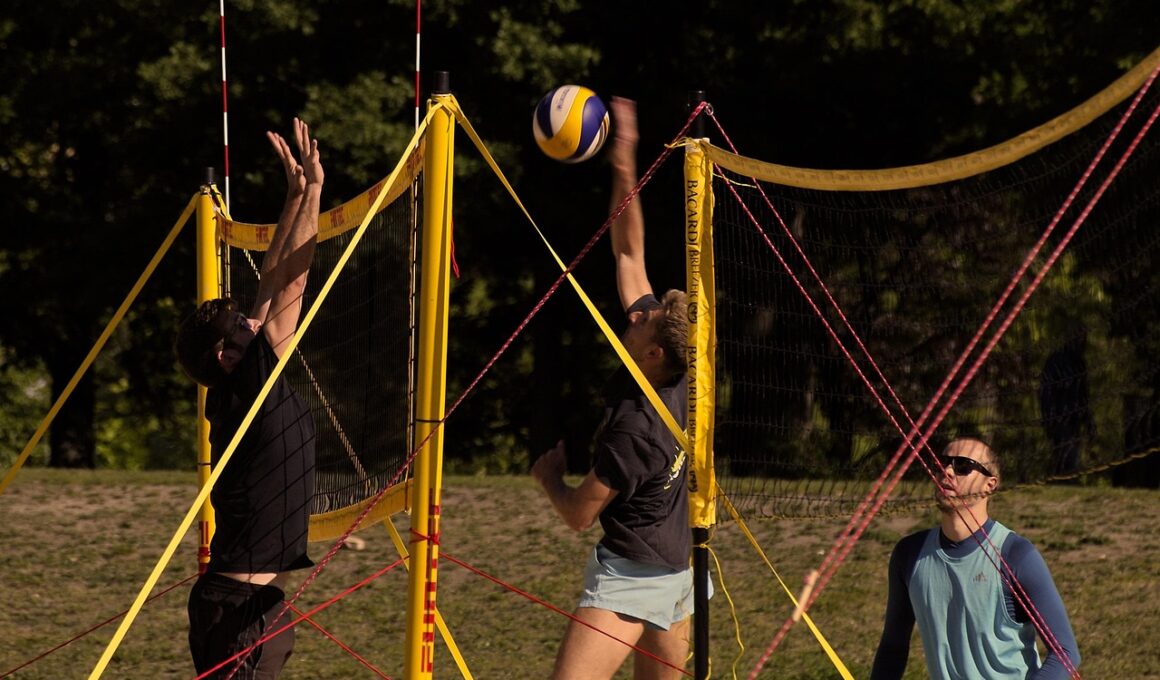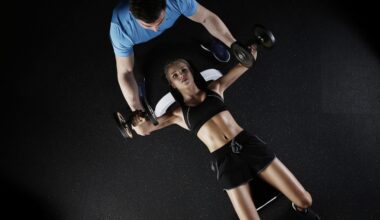Strength Training Exercises Tailored for Beach Volleyball
Beach volleyball is a physically demanding sport that requires strength, speed, and agility. Strength training is essential for athletes who want to excel in beach volleyball, as it enhances their overall performance on the sand. Effective strength training exercises target the major muscle groups used in beach volleyball, including the legs, core, and arms. Traditional gym workouts can be modified to improve the specific muscle functions related to volleyball. Incorporating exercises focused on explosive movement can significantly boost your jumping ability and overall athleticism. A well-rounded strength training regimen includes squats, lunges, and planks, all tailored for volleyball players. Engaging in resistance training, such as using resistance bands or weights, is also crucial. Additionally, training in a beach environment can simulate match conditions, allowing players to develop specific muscle memory. The combination of strength and endurance training will further lead to better long-term results, ensuring you maintain peak performance throughout the match. Consider consulting a coach or professional trainer to design a personalized program suitable for your unique needs and goals in beach volleyball.
To increase your jumping height and improve power, plyometrics are a game-changer. These high-intensity exercises help develop fast-twitch muscle fibers, which are essential for explosive movements in beach volleyball. Some effective plyometric exercises include box jumps, tuck jumps, and depth jumps. Box jumps, in particular, challenge your lower body while enhancing your stability and coordination. Performing these workouts twice a week can significantly increase muscle strength and speed. Incorporating agility drills with plyometrics, such as ladder drills, ensures that the athlete not only jumps higher but can also change direction quickly on the sand. Strengthening the ankle and knee joints is equally important to prevent injuries during high jumps or landings. Implementing exercises like single-leg hops or lateral skater jumps will help achieve this goal. Proper warm-up routines and stretching before starting your plyometric training can further prevent injuries and enhance muscle performance. Experimenting with progressions as your fitness level improves will keep your workouts challenging. Incorporating these elements into your training will yield positive results, leading to increased vertical jump and complete beach volleyball domination.
Core Strength for Better Stability
Core strength is vital for beach volleyball athletes as it aids in maintaining balance and stability while moving on sand. A strong core can significantly enhance an athlete’s overall performance, allowing for smoother transitions and powerful hits. A variety of exercises can better develop core strength. Planks, Russian twists, and medicine ball throws are just a few examples that provide an excellent starting point. In addition, incorporating dynamic movements like mountain climbers or side planks helps improve strength while adding a cardio element. Focusing on the deep abdominal muscles will improve posture and prevent injuries during games. Make sure to integrate these core workouts into your week, ideally 2-3 times weekly. Using stability balls or balance boards for specific exercises can further challenge your core stability. As competition demands increase on the beach, these exercises can make the difference between winning and losing. Regularly evaluating performance for adjustments in training is also key. This ensures that the exercises remain effective and continue to contribute positively towards athletic goals. Building a solid core foundation will undoubtedly translate into better gameplay and overall enjoyment of beach volleyball.
Resistance training with weighted exercises can significantly boost a beach volleyball player’s performance. Basic movements include the squat, deadlift, and bench press, focusing on building strength in the lower body and upper body. Squats train leg muscles for powerful jumps, while deadlifts improve overall strength by targeting the posterior chain. The bench press is crucial for developing upper body strength, which is vital for effective spiking and setting. Adding variations to these exercises, such as goblet squats or single-leg deadlifts, can help challenge muscle stability, as well. For optimal muscle growth and strength gains, aim for at least 3 sets of 8-12 repetitions per exercise. Rest periods are also essential; allow for adequate muscle recovery between sets. Including compound movements that work for multiple muscle groups can maximize workout efficiency and encourage better coordination. Another effective way to increase resistance and strength incrementally is through progressive loading. Seeking professional guidance on form and technique can help ensure maximum results while minimizing injury risks. Finally, mixing resistance training with cardio conditioning can prepare athletes for high-energy beach volleyball matches.
Injury Prevention and Recovery
Injuries in beach volleyball can hinder performance and negatively impact training. Thus, prevention strategies must be integrated into every training routine. Effective reconditioning begins with focusing on flexibility, strength, and stabilization through dynamic warm-ups and cooldowns. Incorporating stretching routines, static and dynamic, helps keep muscles flexible and resistant to injury. A solid warm-up routine should ideally include activities that mimic the sport’s movements, such as arm swings and lunges. Addressing imbalances within the body plays a vital role in injury prevention. Incorporating unilateral exercises like single-leg deadlifts or lunges can help achieve balance and strength throughout each side. Moreover, athletes need to listen to their bodies by adjusting workouts and incorporating rest when necessary. This adaptability can prevent overtraining, which often leads to injuries. Additionally, hydration and proper nutrition contribute to an athlete’s recovery. Consuming a balanced diet rich in protein, healthy fats, and carbohydrates emphasizes muscle recovery after strenuous workouts. Always consult a healthcare professional for more personalized advice on injury prevention and managing fatigue during intense beach volleyball sessions.
Strength training is further enhanced with high-intensity interval training (HIIT), which offers a myriad of benefits for beach volleyball players. HIIT combines short bursts of high-intensity exercise followed by rest periods, which effectively improves both muscular strength and cardiovascular endurance. Integrating HIIT into your weekly schedule can complement resistance training and strength-building exercises; for instance, alternating between jumping drills, sprints, and effective core workouts. The rapid changes in intensity not only train muscles but develop superior mental toughness and overall speed on the court. HIIT should ideally be performed 1 to 2 times a week, considering that recovery strategies should also be factored in. Athletes may opt for different types of intervals based on their fitness levels and goals—varying rest intervals or the duration of high-intensity bursts keeps workouts engaging. Utilizing workout apps or joining group sessions can increase motivation and accountability for HIIT sessions. With consistent practice of HIIT combined with various other strength training modalities, beach volleyball players will notice significant improvements in stamina, speed, and reaction times on the court.
Nutrition for Optimal Performance
Lastly, the role of nutrition cannot be emphasized enough for beach volleyball athletes. A well-rounded diet ensures that players possess the energy needed for high-intensity training and matches. Key nutrients should include a mix of carbohydrates, proteins, and healthy fats to fuel activity. Prior to workouts, athletes must focus on carbohydrate intake to supply the necessary energy reserve. Simple carbohydrates like fruits offer an efficient energy source, whereas complex carbohydrates provide long-lasting energy. Post-training nutrition becomes equally important; consuming protein-rich foods helps kickstart recovery and muscle growth. Lean meats, fish, and plant-based protein sources are excellent choices for this purpose. Healthy fats, such as nuts and avocados, contribute to overall brain function, hormonal balance, and inflammation reduction. Athletes should also maintain proper hydration levels before, during, and after workouts, as dehydration can severely affect performance. Regularly monitoring and adjusting caloric intake based on your training schedule is crucial. Moreover, keeping a food diary can help identify any dietary deficiencies or optimizing strategies to enhance overall performance for beach volleyball success.
In summary, effective strength training exercises are paramount for beach volleyball athletes. Through a combination of plyometrics, core workouts, resistance training, and HIIT, players can develop the essential physical attributes necessary for success in this sport. Incorporating flexibility and injury prevention strategies is critical for ensuring long-term performance. Athletes must commit to a nutrition plan that fuels their energy needs and supports their recovery. Setting clear training goals and tracking progress can result in significant improvements over time. These elements not only contribute to a player’s fitness but also aid in enjoying the game more fully. Consider consulting with professional trainers or sports nutritionists for personalized guidance tailored to your individual needs and goals. Train consistently while practicing a holistic approach, which includes mental preparation on and off the court. The highest level of athleticism can be achieved through dedicated practice and an unwavering focus on improvement. With diligence and appropriate strategies tailored specifically for beach volleyball, you can unlock your full potential and thrive in competitions, significantly improving your individual performance as you engage passionately in the sport.


